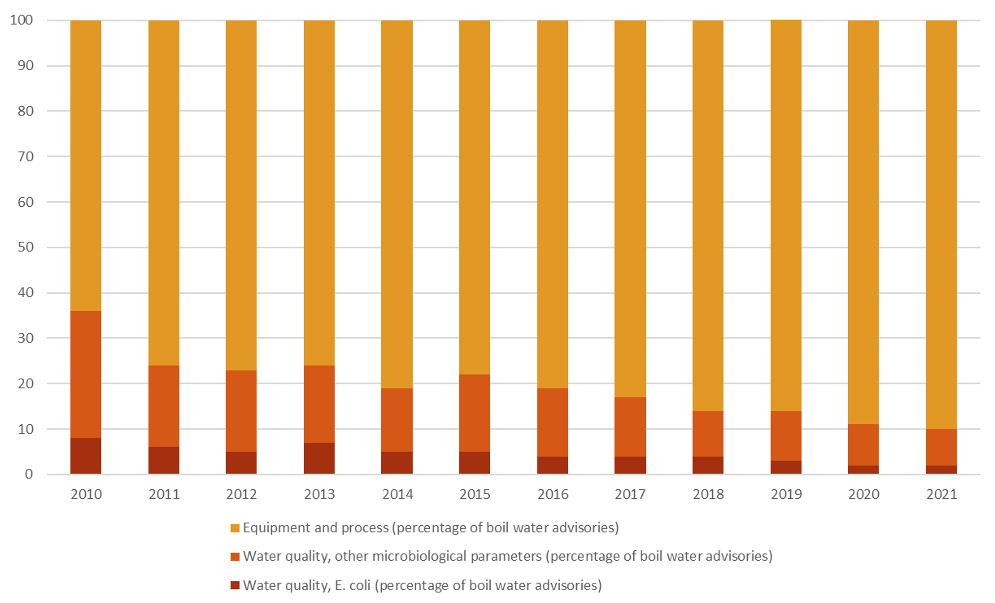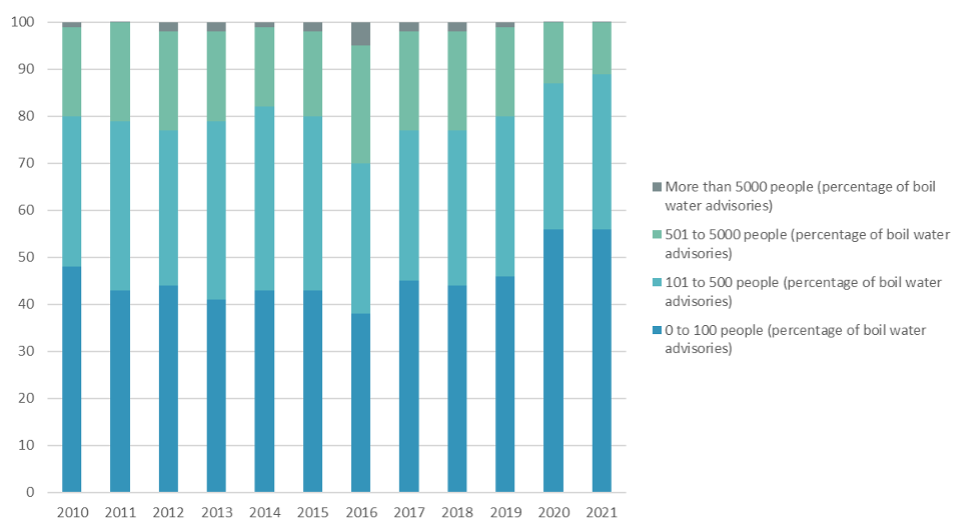- Home
- /
- Environment
- /
- Water Carriers
- /
- Indigenous Services Canada: Water Advisory Portal
Information on this page has been reproduced from Government of Canada’s Environment and Natural Resources portal. Please visit canada.ca to see original content.
Drinking water advisories are public health protection messages about real or potential health risks related to drinking water. These advisories are generally precautionary, meaning they are typically issued before drinking water quality problems occur. The advisories can take 3 forms: Do not consume, Do not use and Boil water. Boil water advisories are by far the most common, representing about 98% of the drinking water advisory data each year. Therefore, this analysis looks only at this type of advisory.
There are 2 indicators for boil water advisories: the first provides a general overview of why boil water advisories are issued in Canada. The second shows the relationship between community size and the frequency of boil water advisories.
In 2021,
Between 2010 and 2021, the percentage of boil water advisories issued on a precautionary basis due to E. coli and other microbiological parameters decreased, while the percentage of boil water advisories issued due to equipment and process-related problems increased.

Note: Data used in this indicator come from various agencies and jurisdictions across Canada that use or share information with the Canadian Network for Public Health Intelligence's Drinking Water Advisories application. They represent a subset (less than 50%) of the Canadian population. A more comprehensive national dataset is not available. The "Water quality, other microbiological parameters" category includes detection of total coliform bacteria and high turbidity levels in drinking water systems. The "Equipment and process" category includes issues such as broken water mains, planned system maintenance, power failures or equipment problems. See the Data sources and methods section for more information.
Source: Canadian Network for Public Health Intelligence (2022) Drinking Water Advisories application.
Boil water advisories are issued as a means to inform consumers that they need to boil their water in order to protect their health against the potential presence of disease-causing bacteria, viruses or parasites.
Most boil water advisories are issued because the equipment and processes used to treat, store or distribute drinking water break down, require maintenance, or have been affected by environmental conditions. In 2021, this accounted for 90% of boil water advisories.
The "Water quality, E. coli" category includes boil water advisories issued due to the detection of E. coli in drinking water samples. This can indicate the potential presence of disease-causing bacteria, viruses or parasites in the water. In 2021, E. coli-related boil water advisories accounted for 2% of the total, which is slightly lower than previous years.
The "Water quality, other microbiological parameters" category includes boil water advisories issued due to the detection of total coliform bacteria or elevated turbidity levels in drinking water. These parameters are not directly linked to health but provide an indication of changing conditions within a drinking water system. This category accounted for 8% of boil water advisories in 2021.
Footnotes:
World Health Organization (2012) Water safety planning for small community water supplies: step-by-step risk management guidance for drinking-water supplies in small communities. Retrieved on June 14, 2022.
World Health Organization (2009) Country profiles of environmental burden of disease: Canada. Quantifying environmental health impacts.
Key results:
Note: Data used in this indicator come from various agencies and jurisdictions across Canada that use or share information with the Canadian Network for Public Health Intelligence's Drinking Water Advisories application. They represent a subset (less than 50%) of the Canadian population. A more comprehensive national dataset is not available. See the Data sources and methods section for more information.
Source: Canadian Network for Public Health Intelligence (2022) Drinking Water Advisories application.

Between 2010 and 2021, the majority of boil water advisories were issued in communities of 500 or fewer people. Boil water advisories are more common in small communities because of the unique challenges those communities face, including limited operational capacity. For example, a broken water main in a larger city is usually isolated and repaired quickly by staff with no need for a boil water advisory. In a smaller community, the same problem may take longer to fix and a boil water advisory may be issued while repairs are completed.
Annual variations in the proportion of boil water advisories issued for communities of a specific size may be explained by several factors, including:
Footnotes:
World Health Organization (2012) Water safety planning for small community water supplies: step-by-step risk management guidance for drinking-water supplies in small communities. Retrieved on June 14, 2022.
World Health Organization (2009) Country profiles of environmental burden of disease: Canada. Quantifying environmental health impacts.
The Boil water advisories indicators provide an overview of the main reasons why boil water advisories are issued, namely:
They also report on the relationship between community size and the percentage of boil water advisories issued each year. The indicators exclude "Do not consume" and "Do not use" advisories, which represent approximately 2% of all drinking water advisories in Canada annually. They also do not report on the length of time a boil water advisory is in effect.
Drinking water advisories are public health protection messages issued by public health or regulatory authorities. The advisories inform those impacted about actions they should take to protect themselves from real or potential health risks related to their drinking water supply.
Although Canada's drinking water is among the safest in the world,Footnote2 understanding key trends related to drinking water advisories helps identify priorities to improve our drinking water infrastructure and operations. This information helps foster consistency and coordination of efforts to enhance the safety and sustainability of drinking water in Canada.
Footnotes:
World Health Organization (2012) Water safety planning for small community water supplies: step-by-step risk management guidance for drinking-water supplies in small communities. Retrieved on June 14, 2022.
World Health Organization (2009) Country profiles of environmental burden of disease: Canada. Quantifying environmental health impacts.